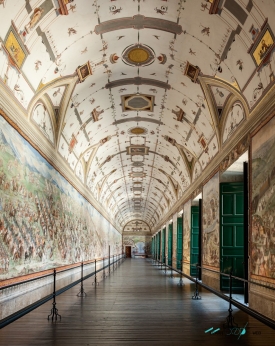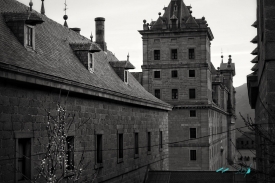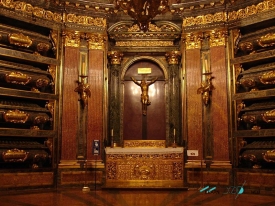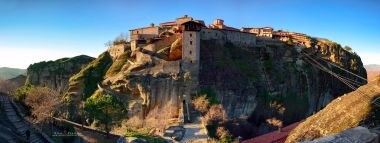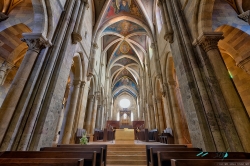ABOUT El Escorial
The Royal Monastery of San Lorenzo de El Escorial is a complex that includes a royal palace, a basilica, a pantheon, a library, a college and a monastery. It is located in the Spanish town of San Lorenzo de El Escorial, in the Community of Madrid, and was built in the 16th century between 1563 and 1584.
The palace was the residence of the Spanish royal family, the basilica is the burial place of the kings of Spain and the monastery – founded by monks of the Order of Saint Jerome – is currently occupied by friars of the Order of Saint Augustine. It is one of the most unique Renaissance architectures in Spain and Europe. Located in San Lorenzo de El Escorial, it occupies an area of 33,327 m², on the southern slope of Mount Abantos, at an altitude of 1,028 m, in the Sierra de Guadarrama. It is managed by National Heritage.
Also known as the Monastery of San Lorenzo El Real, or, simply, El Escorial, it was designed in the second half of the 16th century by King Philip II and his architect Juan Bautista de Toledo, although later Juan de Herrera, Juan de Minjares, Giovanni Battista Castello El Bergamasco and Francisco de Mora. The king conceived a large multifunctional, monastic and palatial complex that, shaped by Juan Bautista de Toledo according to the Universal Trace paradigm, gave rise to the Herrerian style.
Since the end of the 16th century, it was considered the Eighth Wonder of the World, both for its size and functional complexity and for its enormous symbolic value. Its architecture marked the transition from Renaissance Plateresque to unadorned classicism. Huge work, of great monumentality, is also a receptacle for the other arts. Its paintings, sculptures, hymnbooks, scrolls, liturgical vestments and other sumptuary, sacred and courtly objects make El Escorial also a museum. Its complex iconography and iconology has deserved the most varied interpretations of historians, admirers and critics. El Escorial is the crystallization of the ideas and will of its promoter, King Philip II, a Renaissance prince.
The Monastery of San Lorenzo de El Escorial was promoted by Felipe II, among other reasons, to commemorate his victory in the battle of San Quintín, on August 10, 1557, the feast of San Lorenzo. This battle marked the beginning of the planning process that culminated in the laying of the first stone on April 23, 1563, under the direction of Juan Bautista de Toledo. He was succeeded after his death, in 1567, by the Italian Giovanni Battista Castello El Bergamasco and, later, by his disciple Juan de Herrera. The last stone was laid twenty-one years later, on September 13, 1584.
The building arises from the need to create a monastery that would ensure worship around a newly created family pantheon, in order to comply with the last will of Carlos I of 1558. The Emperor wanted to be buried with his wife Isabella of Portugal and with his new dynasty away from the usual burial places of the Trastámara.
The Foundation Charter, signed by Felipe II on April 22, 1567, four years after the start of the works, indicated that the Monastery was dedicated to San Lorenzo, but without directly mentioning the battle of San Quintín, probably to avoid citing a war as the reason for the foundation of a religious building: it was "founded out of devotion and in the name of the blessed San Lorenzo for the particular devotion" to the saint of the king and "in memory of the mercy and victory that on the day of his feast of God we began to receive”. The "considerations" cited by the king were gratitude to God for the benefits obtained, for maintaining his Kingdoms within the Christian faith in peace and justice, for worshiping God, for burying himself in "a crypt" the king himself, his women, brothers, parents, aunts and successors, and where continuous prayers were given for their souls.
On November 2, 1984, UNESCO declared the Monastery and Site of El Escorial a World Heritage Site. It is one of the main tourist attractions in the Community of Madrid. The monumental complex receives more than 500,000 visitors a year.
The palace was the residence of the Spanish royal family, the basilica is the burial place of the kings of Spain and the monastery – founded by monks of the Order of Saint Jerome – is currently occupied by friars of the Order of Saint Augustine. It is one of the most unique Renaissance architectures in Spain and Europe. Located in San Lorenzo de El Escorial, it occupies an area of 33,327 m², on the southern slope of Mount Abantos, at an altitude of 1,028 m, in the Sierra de Guadarrama. It is managed by National Heritage.
Also known as the Monastery of San Lorenzo El Real, or, simply, El Escorial, it was designed in the second half of the 16th century by King Philip II and his architect Juan Bautista de Toledo, although later Juan de Herrera, Juan de Minjares, Giovanni Battista Castello El Bergamasco and Francisco de Mora. The king conceived a large multifunctional, monastic and palatial complex that, shaped by Juan Bautista de Toledo according to the Universal Trace paradigm, gave rise to the Herrerian style.
Since the end of the 16th century, it was considered the Eighth Wonder of the World, both for its size and functional complexity and for its enormous symbolic value. Its architecture marked the transition from Renaissance Plateresque to unadorned classicism. Huge work, of great monumentality, is also a receptacle for the other arts. Its paintings, sculptures, hymnbooks, scrolls, liturgical vestments and other sumptuary, sacred and courtly objects make El Escorial also a museum. Its complex iconography and iconology has deserved the most varied interpretations of historians, admirers and critics. El Escorial is the crystallization of the ideas and will of its promoter, King Philip II, a Renaissance prince.
The Monastery of San Lorenzo de El Escorial was promoted by Felipe II, among other reasons, to commemorate his victory in the battle of San Quintín, on August 10, 1557, the feast of San Lorenzo. This battle marked the beginning of the planning process that culminated in the laying of the first stone on April 23, 1563, under the direction of Juan Bautista de Toledo. He was succeeded after his death, in 1567, by the Italian Giovanni Battista Castello El Bergamasco and, later, by his disciple Juan de Herrera. The last stone was laid twenty-one years later, on September 13, 1584.
The building arises from the need to create a monastery that would ensure worship around a newly created family pantheon, in order to comply with the last will of Carlos I of 1558. The Emperor wanted to be buried with his wife Isabella of Portugal and with his new dynasty away from the usual burial places of the Trastámara.
The Foundation Charter, signed by Felipe II on April 22, 1567, four years after the start of the works, indicated that the Monastery was dedicated to San Lorenzo, but without directly mentioning the battle of San Quintín, probably to avoid citing a war as the reason for the foundation of a religious building: it was "founded out of devotion and in the name of the blessed San Lorenzo for the particular devotion" to the saint of the king and "in memory of the mercy and victory that on the day of his feast of God we began to receive”. The "considerations" cited by the king were gratitude to God for the benefits obtained, for maintaining his Kingdoms within the Christian faith in peace and justice, for worshiping God, for burying himself in "a crypt" the king himself, his women, brothers, parents, aunts and successors, and where continuous prayers were given for their souls.
On November 2, 1984, UNESCO declared the Monastery and Site of El Escorial a World Heritage Site. It is one of the main tourist attractions in the Community of Madrid. The monumental complex receives more than 500,000 visitors a year.
The Best Pictures of El Escorial
Videos of El Escorial




















